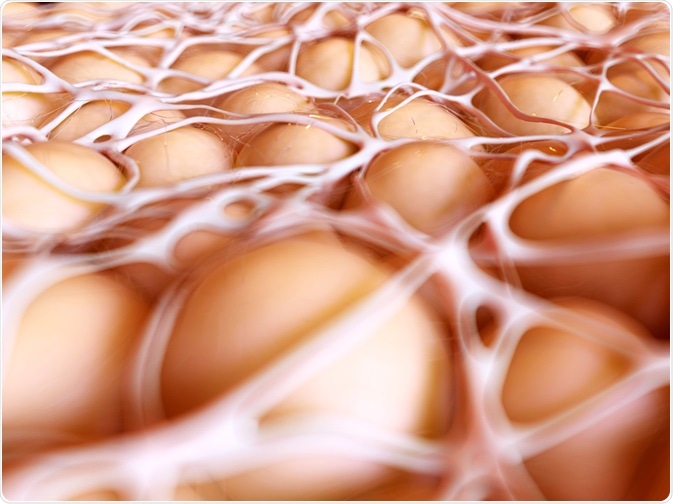In mammals, two types of adipose tissue have been observed: White Adipose Tissue, (WAT), which stores excess energy as triglycerides, and Brown Adipose Tissue (BAT), which dissipates stored energy as heat.
 Sebastian Kaulitzki | Shutterstock
Sebastian Kaulitzki | Shutterstock
WAT and BAT function antagonistically–WAT stores energy and BAT releases energy. The balance between these two cell types changes over an organisms' lifetime.
Microscopic view of brown and white fat
Constituents of brown and white fat
The major microscopic constituent of white adipocytes is triglycerides, which are stored in a large, single (unilocular) droplet. Surrounding this white triglyceride droplet is a thin ring comprising the cytoplasm and nucleus.
Brown adipocytes are smaller than white adipocytes and contain multitudes of small (multilocular) lipid droplets. They also contain fewer mitochondria than brown adipocytes. Their brown appearance results from high-density vasculature together with high mitochondrial density.
Brown adipocytes contain a large number of mitochondria in their cytoplasm, which express Uncoupling Protein 1 (UCP1), a protein that stimulates the process of non-shivering thermogenesis.
Energy metabolism
Individual triglyceride molecules can be oxidatively metabolized under conditions of energy scarcity to provide energy for metabolizing cells. In addition, white adipocytes provide insulation and contribute to endocrine function as they secrete hormones.
These hormones are referred to as adipokines and include the satiety and hunger hormones, ghrelin and leptin. Moreover, white adipocytes have a low oxidative rate, which is the rate of macronutrients (protein, fat, and carbohydrate) metabolism.
Location of brown and white fat
WAT can be further classified according to its location. WAT located under the skin is referred to as subcutaneous fat and represents the primary type of WAT in the body.
Visceral WAT surrounds the inner organs and is much less innervated and vascularised than BAT. An important difference between these two types of WAT is that visceral WAT is correlated with poor insulin sensitivity, type II diabetes, and other obesity-related diseases.
The relevance of brown adipocytes in Humans
Small mammals and new-borns are predisposed to temperature loss owing to their small volume to surface area ratio. The insulation provided by WAT, together with muscular contraction (shivering), are means of maintaining core temperature. Historically, the significance of BAT in adults was regarded as minimal or absent.
Recent research, however, has revealed that BAT is present in a major subset of the adult population where it functions oxidatively, causing a significant increase in the basal metabolic rate (BMR). It thus contributes to increased energy expenditure, which is correlated with decreased Body Mass Index (BMI).
In light of this discovery, considerable interest has accumulated in assimilating the characteristics of BAT in regions of WAT (browning), particularly in obese adults. This is important as several comorbidities suffered by obese individuals are associated with excess WAT.
Experiments performed in mice and humans have revealed that subcutaneous WAT can acquire BAT characteristics which include fatty acid and glucose utilization. This has fuelled the therapeutic interest in the transformation of energy-storing into energy-dissipating adipocytes.
Brite adipocytes and their therapeutic potential
The mechanism underlying the transformation of WAT is unknown. WAT can transdifferentiate (transforms from one mature somatic cell type into another) into BAT. Alternatively, if immature precursors of BAT are already present in WAT, these can differentiate into mature brown adipocytes.
These induced brown adipocytes in WAT are referred to as Brown in white (brite) or ‘beige’ adipocytes and differ from conventional BAT in infants. They possess lower levels of UCP1 but are capable of significantly increasing UCP1 expression in response to adrenergic activation.
More recent evidence has revealed that adult BAT is of the 'brite' variation, in contrast to the BAT variant found in infants. To date, only fibroblast growth factor 21 (FGF21) has been studied as a potential therapeutic treatment for obesity. The design of future treatments to target obesity and associated comorbidities is based on how WAT acquires BAT characteristics.